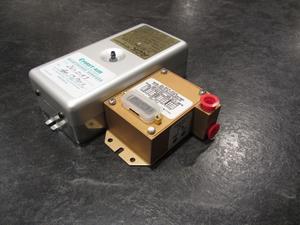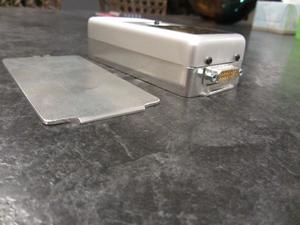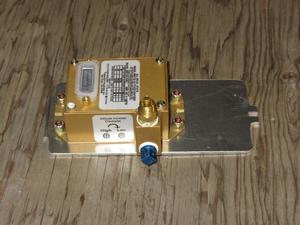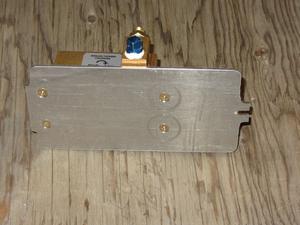I’ve been plagued with altimeter and altitude encoder issues, but I think I’m over them now. Several months ago, during a cold snap, the altimeter setting knob on my cheap, Chinese, Falcon altimeter became very stiff to turn. It took so much effort to turn it that it would unscrew off the shaft. Fortunately I’ve also got a Dynon EFIS with an altimeter, so I simply used that. I had chosen the Falcon altimeter as it was a lot cheaper than a “name brand” altimeter, and I could risk reliability problems with it as I knew I would also have the altimeter in the EFIS. Now that it had failed, I decided to spend the cash for a better quality altimeter. I bought a used United Instruments altimeter and had it overhauled.
Several weeks ago ATC reported that the altitudes reported by my transponder were about 200 ft lower than the altitudes shown by my two altimeters. This problem was evident again on all subsequent flights. It was quite clear that the ACK A–30 altitude encoder had drifted out of tolerance, for the second year in a row. It had worked fine from 2008 to early 2012, but it drifted down during 2012. I had it recalibrated at an overhaul shop, and it was OK for a few months, when it went out of tolerance again.
I had chosen the ACK altitude encoder, as it was the only low cost altitude encoder that seemed to get good reviews when I researched this in the early 2000s. It and the Ameri-King encoder sold for about $150, and the next cheaper ones went for about $1000. The $150 ACK encoder was worth a try.
After the second time it went out of tolerance, I did some more research. I found several people with similar complaints, and it seems that many of them work for 4–5 years, then continually drift out of tolerance. Drat!!
 Fortunately there is now another low cost option on the market, the Trans-Cal SSD120, and it apparently has much better service history, and is pin-compatible with the ACK A–30. I ordered one from ACS. After receiving it, I was happy to see that the Trans-Cal encoder is much smaller and lighter than the ACK A–30 it was replacing.
Fortunately there is now another low cost option on the market, the Trans-Cal SSD120, and it apparently has much better service history, and is pin-compatible with the ACK A–30. I ordered one from ACS. After receiving it, I was happy to see that the Trans-Cal encoder is much smaller and lighter than the ACK A–30 it was replacing.
 The ACK altitude encoder is secured in its mounting tray by a protruding lip at one end, and a knurled nut at the other. Trans-Cal sells an adapter plate that is bolted to the bottom of their altitude encoder - the adapter plate is the same size and shape as the ACK altitude encoder, so it can be secured in the same tray. But, ACS was out of stock on the adapter plates, so I made my own.
The ACK altitude encoder is secured in its mounting tray by a protruding lip at one end, and a knurled nut at the other. Trans-Cal sells an adapter plate that is bolted to the bottom of their altitude encoder - the adapter plate is the same size and shape as the ACK altitude encoder, so it can be secured in the same tray. But, ACS was out of stock on the adapter plates, so I made my own.
 The Trans-Cal encoder secured to the adapter plate.
The Trans-Cal encoder secured to the adapter plate.
 Flat head #6 screws secure the encoder to the plate.
Flat head #6 screws secure the encoder to the plate.
I was concerned that I after replacing the altimeter and altitude encoder, that I may be required to have another transponder “correlation” test done. The “correlation” or integration test, confirms that the altitudes reported by the altitude encoder match those shown on the altimeter. But, when I took a closer look at the regulations, I found that there is a “let” that covers my situation. The altimeter had recently been overhauled and calibrated by Woodlawn Instruments, and the altitude encoder was a new TSO’d unit, which had been calibrated at the factory, so AWM 571 Appendix F, para (k)(3) applies:
when the maintenance performed consists of the installation of a line replaceable unit (LRU) and the installed LRU is a known airworthy part, the integration test need not be accomplished if an operational test is carried out prior to flight.
Notwithstanding the above, I deemed it prudent to conduct a correlation test. I didn’t have access to an air data test set to apply calibrated suction to the static system during a ground test, so I did the correlation test in flight. AWM 571 Appendix F specifies the following altitudes to be checked when performing a “correlation” test:
- 500 ft
- 1,300 ft
- 2,700 ft
- 10,000 ft
- 14,800 ft
- 30,800 ft
Most altitude encoders transmit the altitude information via 9 - 12 wires using a modified Gray Code. These specific altitudes were chosen as they allow all data lines to be checked for both high and low (i.e. “1” or “0”). The altitude encoder transmits the pressure altitude in 100 ft increments, and the test consists of noting the altimeter indication at which the altitude encoder switches to and from the target altitude. E.g, when climbing, note the altimeter reading when the altitude encoder output switches from 1,200 ft to 1,300 ft, and from 1,300 ft to 1,400 ft. Note that the altimeter must be set to 29.92, so it is showing pressure altitude.
Given that the aircraft is based at Smiths Falls, at 415 ft elevation, it wasn’t practical to do a 500 ft test point. I also couldn’t legally check the 14,800 ft point without using oxygen. I looked at how the wires are used to transmit the altitude info, and saw that:
- only 8 of the wires were used for altitudes of 14,700 ft and below.
- replacing the 500 ft test point with one at 6,800 ft, would ensure that all 8 wires used below 14,800 ft were checked at both low and high by one of the test points. I.e., if one of the wires was stuck low or high, it would fail at least one of the test points.
Wire -> A1 A2 A4 B1 B2 B4 C1 C2 C4 D1 D2 D4 ALTITUDE 500 0 0 0 0 1 0 0 1 0 0 0 0 1300 0 0 0 1 1 1 1 0 0 0 0 0 2700 0 0 0 1 0 0 0 0 1 0 0 0 10000 0 1 1 1 0 1 0 1 0 0 0 0 14800 1 1 0 0 0 0 0 0 1 0 0 0 30800 1 0 0 0 0 0 0 0 1 0 0 1 6800 0 1 1 0 0 0 0 0 1 0 0 0
On Saturday, I checked the altitude encoder at 1300, 2700, 6800 and 10,000 ft, using the pressure altitude display on the Garmin GTX–327 transponder to tell me what the altitude encoder was saying. I found that the errors ranged from 35 to 50 ft, which is well within the maximum allowable error of 125 kt.